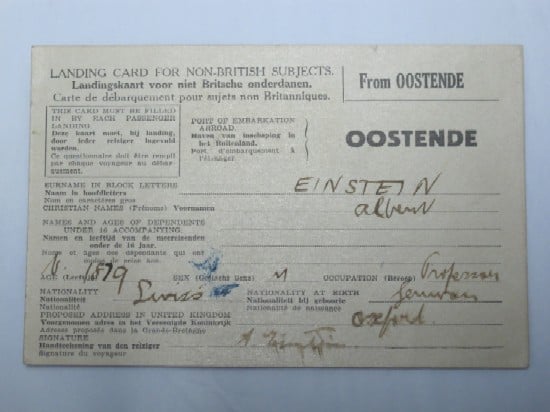
Courtesy: National Museums Liverpool
By James Dacey
This unremarkable piece of paper belongs to a chapter in one of the most extraordinary lives of the 20th century.
It is the recently discovered landing card issued to Albert Einstein in 1933 when he arrived in Britain after fleeing Nazi Germany.
On Tuesday the card went on public display for the first time at the Merseyside Maritime Museum in Liverpool, having been stored away for nearly 80 years at Heathrow Airport.
“We were keen on acquiring any documents relating to immigration but were stunned to find paperwork relating to such a prominent historical figure as Albert Einstein,” Lucy Gardner, curator of the exhibition about customs and immigration.
The document brings proof that Einstein arrived in Dover on 26 May 1933 after sailing from Ostende in Belgium. The “professor” states that he was heading for Oxford, a city he had visited previously during stays at Christ Church College.
Einstein lists his nationality as Swiss having renounced his German citizenship only weeks earlier in angry reaction to Nazi policies. In April 1933 Hitler’s party had passed a law barring Jews from holding any official positions, including teaching at universities. And during a visiting professorship at the California Institute of Technology, Einstein – who was Jewish by birth – had learned that his name had been added to a list of Nazi assassination targets.
Upon his return to Europe Einstein resided in Belgium for a brief time before sailing to Britain. Shortly afterwards, Einstein took up his position at the Institute for Advanced Study at Princeton an affiliation that lasted until his death in 1955.
“This tiny piece of paper brings to life Einstein’s escape from the Nazis to England,” said Gardner.

Curator Lucy Gardner with Einstein’s landing card



